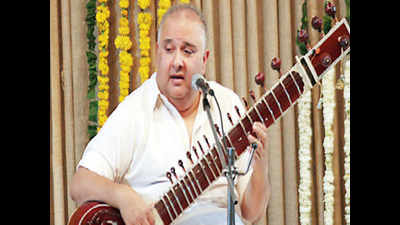- News
- City News
- ahmedabad News
- String theory of Indian music’s greatness
Trending
This story is from January 7, 2017
String theory of Indian music’s greatness
Ustad Shujaat Khan, the sitar maestro of the Imdad Khan Gharana, began his concert by acclaiming Amdavadi rasikas.

Ustad Shujaat Khan
AHMEDABAD: Ustad Shujaat Khan, the sitar maestro of the Imdad Khan Gharana, began his concert by acclaiming Amdavadi rasikas. “It is midnight and if someone were to invite me to attend a Shujaat Khan recital at 12:00 am, I would say no!” he said. His self-deprecatory jibe plucked the string of laughter inside the Saptak venue on Thursday, Day 5 of the festival.
Warmed by the appreciation, the audience held their smiles as their eyes closed in the anticipation of the alaap.Khan-sahab had announced he would play Raga Maru Bihag. What was laid out by Khan-sahab appeared to be a beloved memory made more fulfilling by bolder imaginings. Maru Bihag has been a frequent Saptak theme. Many renditions of the raga still hum in the minds of veteran rasikas of the festival. One of them was the shehnai tour de force in the 2012 edition of Saptak by Ustad Ali Abbas Khan, the son-in-law and disciple of Ustad Bismillah Khan. Another was the vocal magnum opus by Begum Parveen Sultana on the opening day of this year’s edition.
On Thursday, Ustad Shujaat Khan, however, found yet another interpretative axis on which Maru Bihag developed a newer ambition. “Khan-sahab presented an experiment while adhering to all the rules of the raga,” Manju Mehta told TOI. Mehta is the guardian of the Saptak legacy. Indeed, discoveries from Khan-sahab’s exploration seemed unbelievable precisely because the voyage was made while still anchored to the raga’s essence.
During the alaap, for example, Khan-sahab let silence take over extraordinary expanses between notes. And after he made a note flutter, he often let go off the hand that held the plectrum, waving his palm at the audience — as if releasing a dove into the crowd.
Warmed by the appreciation, the audience held their smiles as their eyes closed in the anticipation of the alaap.Khan-sahab had announced he would play Raga Maru Bihag. What was laid out by Khan-sahab appeared to be a beloved memory made more fulfilling by bolder imaginings. Maru Bihag has been a frequent Saptak theme. Many renditions of the raga still hum in the minds of veteran rasikas of the festival. One of them was the shehnai tour de force in the 2012 edition of Saptak by Ustad Ali Abbas Khan, the son-in-law and disciple of Ustad Bismillah Khan. Another was the vocal magnum opus by Begum Parveen Sultana on the opening day of this year’s edition.
On Thursday, Ustad Shujaat Khan, however, found yet another interpretative axis on which Maru Bihag developed a newer ambition. “Khan-sahab presented an experiment while adhering to all the rules of the raga,” Manju Mehta told TOI. Mehta is the guardian of the Saptak legacy. Indeed, discoveries from Khan-sahab’s exploration seemed unbelievable precisely because the voyage was made while still anchored to the raga’s essence.
During the alaap, for example, Khan-sahab let silence take over extraordinary expanses between notes. And after he made a note flutter, he often let go off the hand that held the plectrum, waving his palm at the audience — as if releasing a dove into the crowd.
In short, on Thursday, Khan-sahab set up the exemplary demonstration of the principle that Indian classical musicians can reveal infinite vistas from the vantage of the same raga. And it bears another saying that Maru Bihag is also the musical summit to which “Tum toh pyaar ho” of the 1960s Bollywood film “Sehraa” aspired.
End of Article
FOLLOW US ON SOCIAL MEDIA










